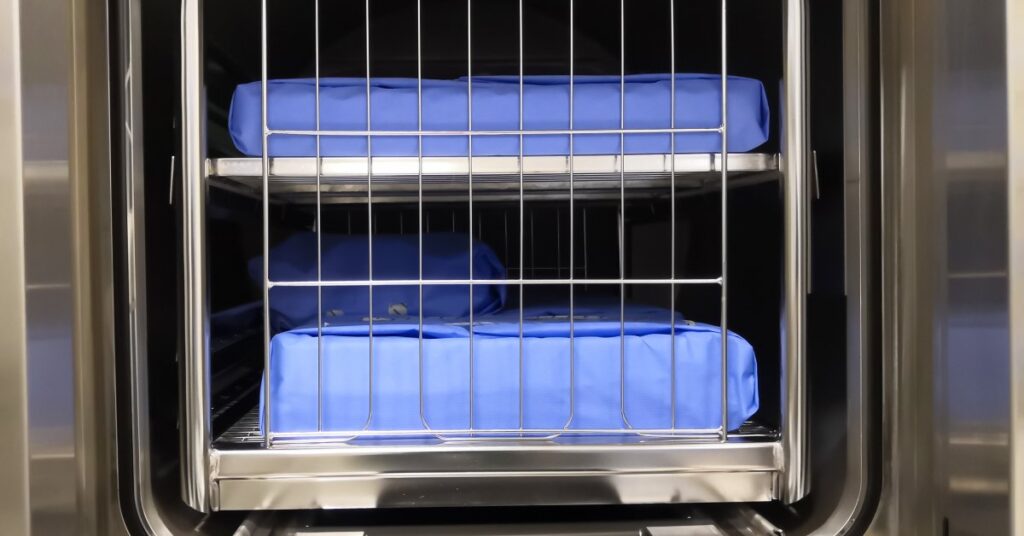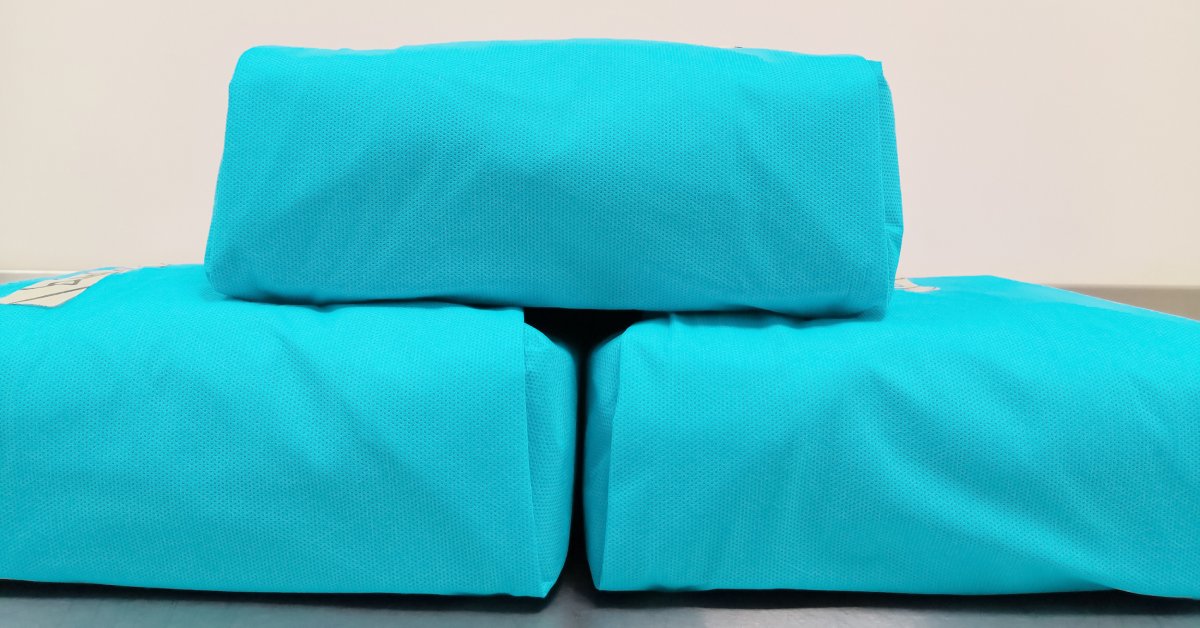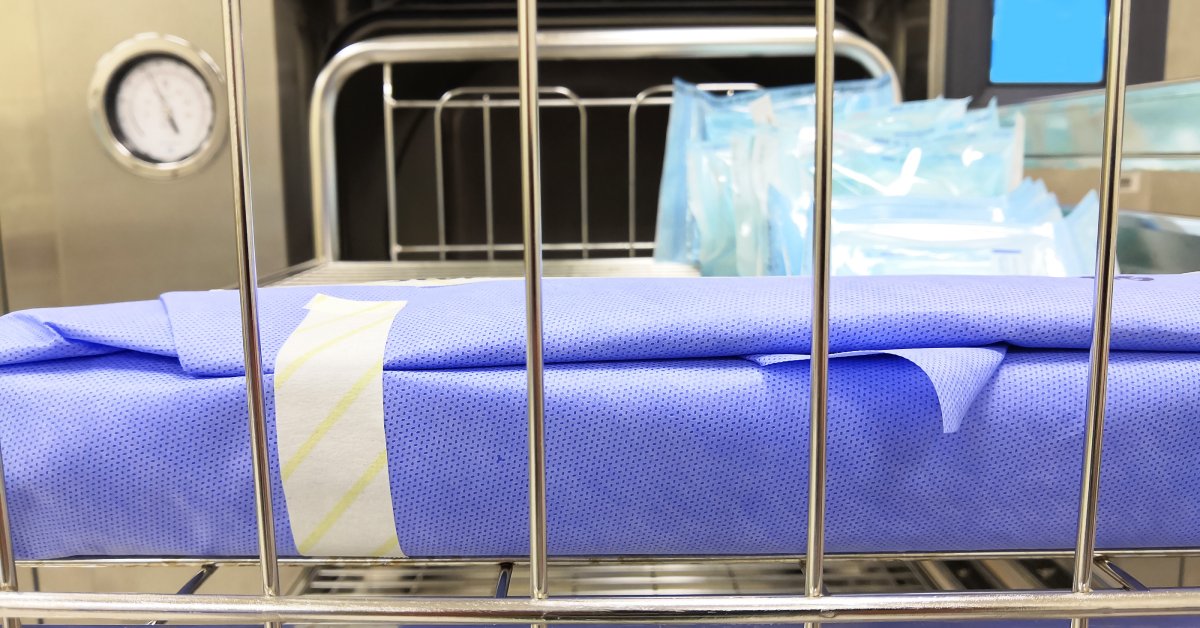There are many different kinds of validation tests manufacturers can use to determine if their packaging system is effective at maintaining sterility of contents. Finding the right test means determining what best simulates the real-world environment and intended use of your device’s packaging system. Learn more about the guidelines that influence terminal medical device packaging and compare some of the different types of validations for medical device packaging with this overview.
What Is Medical Device Packaging Validation?
The goal of terminal medical device packaging validation is to ensure that the intended packaging system for a specific medical device can create and maintain a sterile barrier around the device throughout its shelf life.
This form of packaging occurs as part of medical device reprocessing. After using and cleaning a reusable medical device, healthcare professionals then prepare the device for sterilization by packaging it with a terminal sterilization wrap, a sterilization pouch, or rigid container. The chosen packaging system contains the device throughout the sterilization process. After sterilization, it maintains the sterile barrier and keeps the device safe until its next use.
Validation testing helps determines whether a packaging system can effectively maintain the sterility of the device after reprocessing and throughout its shelf life and to point of use. Validation procedures focus on the integrity of the packaging’s seal and sterile barrier system. They also help determine the length of a device’s shelf life, the safety and efficacy of packaging labeling systems, and other factors. These factors are necessary to create a safe and reproduceable packaging procedure as part of device reprocessing.
ISO 11607
Regulatory authorities for packaging validation may vary depending on the manufacturer’s location and target market, the type of device you’re working with, and other factors. The International Organization for Standardization (ISO) covers packaging validation procedures and guidelines for terminal medical device packaging with ISO 11607 series of standards.
ISO 11607-1
ISO 11607 is split into two parts. The first, ISO 11607-1, defines the sterile barrier system of terminal medical device packaging as the minimum packaging requirement to prevent microorganisms from breaching the packaging system and reaching the device. The sterile barrier system is the key to maintaining sterility and enabling aseptic opening of the package and retrieval of the device at the point of use.
ISO 11607-1 also discusses how to validate a packaging system’s integrity. This validation applies not just to the sterilization process itself, but to all the handling and storage that occurs after reprocessing and before the device reaches its next point of use. By following the guidelines of ISO 11607-1, validation demonstrates whether or not the sterile barrier system can remain intact throughout the device’s shelf life.
ISO 11607-2
The second part, ISO 11607-2, states that manufacturers must validate all processes related to a packaging design’s sterile barrier system. The goal of this validation is to demonstrate that creating and maintaining the barrier is a process that healthcare professionals—such as a technician in a central service department—can effectively follow in a clinical setting. ISO 11607-2 details steps such as equipment installation qualification, operational qualification, and performance qualification to evaluate and validate the packaging process.
Aerosol Challenge Tests
Aerosol challenge tests make up some of the most common types of validations for medical device packaging. Also known as whole package integrity testing, aerosol challenge tests are extremely rigorous tests where a packaging system is first processed in a specific sterilization cycle, then exposed to a high concentration of bacterial spores in an aerosol chamber.
The goal is to determine if the packaging system maintains its integrity (sterile barrier) during exposure to the microorganisms. If there is no microbial growth of the tests items within the packaging system at the end of the test, the packaging system has proven its an effective barrier.
During a whole package integrity test, a packaging system is exposed to a high concentration of spores over a short period of time to mimic weeks, months or even years of real time bioburden that may have accumulated outside of the barrier during terminal storage in a healthcare setting.
AC-STERRAD
AC-STERRAD is an Aerosol Challenge test that involves processing the packaging system in a STERRAD cycle prior to exposure in the aerosol chamber. STERRAD is a sterilization method that uses hydrogen peroxide molecules to sterilize a medical device.
AC-ETO
AC-ETO sterilizes the packaging system in an ethylene oxide cycle before placing it in the aerosol chamber and exposing it to bacterial spores.
AC-STEAM
AC-STEAM is the steam whole package integrity test. It involves processing the packaging system in a steam cycle before bacterial exposure in an aerosol chamber.
AC-VPRO
AC-VPRO is an Aerosol Challenge test that processes the packaging system in a V-Pro cycle. Like STERRAD, V-Pro is a low-temperature sterilization method that uses hydrogen peroxide molecules to sterilize a medical device..
Shelf-Life Study
Shelf-life studies include both real-time and accelerated aging shelf-life tests. The goal of this validation is to determine the post sterilization processing shelf life of a device and its packaging system. These findings go on to inform instructions for use, storage conditions, and other requirements that help ensure safe use of reusable medical devices.
SL-ACCEL
SL-ACCEL refers to accelerated aging shelf-life testing. This validation involves testing the packaging system in an accelerated aging chamber that simulates real-life storage time through stressors such as increased temperature, humidity, and pressure. This test allows manufacturers to gather shelf life data in a shorter period of time when compared to a real time shelf life study.
SL-STEAM
SL-STEAM is a real-time shelf-life validation that demonstrates the packaging system’s ability to maintain a sterile barrier after exposure to a steam sterilization process. As with all real time shelf-life studies, after the sterilization process, professionals store the packaging system for a set period of time, then examine it to determine if it maintained its sterile barrier.
SL-STERRAD
This real-time shelf-life exposure test studies the packaging system’s ability to maintain a sterile barrier after exposure in the STERRAD sterilization process. Regulatory agencies look for a minimum of 30 days of real time shelf-life testing but most manufacturers choose to go with longer periods such as 1 year or even longer.
SL-VPRO
SL-VPRO studies the effects of real-time shelf-life on the sterile barrier after the packaging system undergoes V-Pro sterilization.
SL-ETO
SL-ETO tests real-time shelf-life exposure after an ethylene oxide sterilization cycle.
Bubble Emission
The Bubble Emission test, or BE-ISO, is another form of whole package integrity testing that is typically used with Tyvek pouches or form fill packaging. It involves inflating the packaging system within its tolerance range, then submerging it in water. Testers then study the water to identify any bubbles that rise. The presence of bubbles indicates air coming from the package, which means there is a failure in the packaging seal.
Dye Migration
Dye migration, or DM-ISO, tests the seal of the packaging system, typically self-seal or heat seal pouches by adding dye to the interior of the package and allowing it to rest on the seal for a prescribed period of time. If the dye bleeds through the seal, it indicates there is a flaw in the packaging system.
Bacterial Filtration Efficiency
Bacterial Filtration Efficiency testing, or BFE, follows standards from ASTM F2101-07 and EN14683:2014, Annex B. This test was developed to test medical face masks but it is also used to determine the filtration of a packaging material—such as sterilization wrap or a rigid container filter—by studying a ratio of challenge organisms and determining filtration percent efficiency. Once the filtration efficiency is determined, it allows regulatory agencies and manufacturers to compare the materials used in packaging system products.
Seal Integrity
Seal integrity tests evaluate the usability of a packaging system such as heat seal or self-seal sterilization pouches, to ensure they create an effective seal around the medical device. These types of validation identify any potential issues that might compromise the integrity of the seal and the sterile barrier system during storage. This ensures that the packaging design and processes hold up in a real-world healthcare setting.
Seal Peel
SP-ISO, or Seal Peel testing, determines the amount of strength necessary to open a packaging system such as a sterilization pouch. Documenting and comparing this information to product specifications helps determine critical instructions for use.
Burst Test
A Burst Test, or BT-ISO, applies pressure to the weakest seal on the packaging system until the seal breaks and the package fails. Professionals then document this information and use it to analyze and inform product specifications.
Highpower offers a wide range of medical device package integrity testing to validate your packaging systems and processes. Reach out today to find the right validation procedures for your project.


